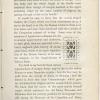Drawing of a window
Commentary
Drawing in ink by Arthur Evans of a window, labelled ‘Outline of window tracery’, identified as a depiction of an unglazed, metal tracery window in a building (upper storey or outhouse) in Zagreb, Croatia.
Artist: Arthur John Evans
Date of drawing: August 1875
Continent: Europe
Geographical area: Southern Europe
Country: Croatia
Region/Place: Zagreb
Cultural group: European Croat
Format: Drawing
Size: 104 x 70 mm
Acquisition: Joan Evans. Donated August 1941
***
Exhibition caption: ‘One of a selection of drawings and ink sketches made by Arthur Evans while travelling with his brother through Bosnia and Herzegovina in the summer of 1875. They show people and places encountered by the pair on a route south from Agram (modern-day Zagreb) – via Tešanj, Sarajevo and Mostar – to Ragusa (Dubrovnik), which Evans and his wife were later to make their home. The illustrations demonstrate a particular interest in identity and dress, Evans writing, for example, of finding “two Bulgarians hard at work tying up bundles of onions, clad in their dark national costume – the brown tight-sleeved jacket embroidered with black, the dull red sash, the brown trowser-leggings which are equally Turkish and Tartar and on their head the black sheepskin cap which had at first attracted my attention.” As well as being an aide-mémoire, the drawings provided the basis for engravings published in Evans’ account of his journey, Through Bosnia and the Herzegóvina on Foot during the Insurrection, August and September 1875 (London, 1876). As an eyewitness account of a distant region in turmoil, the book was an immediate success, quoted extensively in Parliament, and it went into a second edition the following year.’ Source: ‘Travels in Finland and Bosnia-Herzegovina: An Ethnographic Collection of Sir Arthur Evans’, exhibition curated by Philip Grover, Pitt Rivers Museum, University of Oxford, 29 April to 1 September 2013.
Primary documentation: ‘[p.588] Dr. JOAN EVANS, from the property of the late SIR ARTHUR EVANS, Youlbury, Boars Hill, Oxford. [List of items follows]’; ‘[p.590] 21 Original pencil sketches, types & scenery. BALKANS’: Pitt Rivers Museum accession records (Donations X, 1937–1941), pp.588, 590. Annotations on drawing: ‘Note (Outline of window tracery.)/ This tracery is pierced and is not mere lattice-work. Perhaps it will be well to make the white bars a little broader!’ (written in black ink below drawing).
Research notes: It has been identified by Philip Grover that this original drawing was used as the artwork for a woodcut engraving subsequently published in Arthur J. Evans, Through Bosnia and the Herzegóvina on Foot during the Insurrection, August and September 1875 (London, 1876), p.23, printed with the caption ‘Outline of Tracery’. Evans recorded in the volume: ‘It would be easy to show that the conical-shaped baskets, the Corpa, which the Croat countryman on p.4 has in his hand, is as like the Roman Corbis in form as it is in name, and may claim sisterhood with the Corbella of the Campanian peasant of to-day. Some even of the windows of Agram have a Roman air, for in several upper-storeys and outhouses, to save glass, they are provided with a heavy unglazed plate tracery of an angular kind, which is an exact reproduction of the Roman tracery, to be seen, for example, in the Amphitheatre of Pola in Istria’: Through Bosnia and the Herzegóvina on Foot, p.23. Note that Agram is the German name for Zagreb, Croatia.

